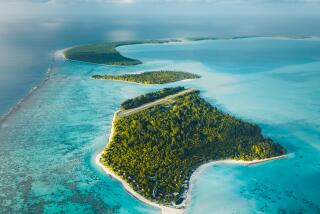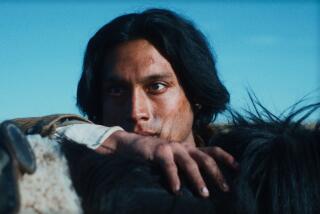Not for the Squeamish : Don’t read this over a meal--we’re serious : CONVERSATIONS WITH THE CANNIBALS: The End of the Old South Pacific, <i> By Michael Krieger (The Ec</i> c<i> o Press: $23; 291 pp.)</i>
My father, a doctor in the South Seas, once ate human flesh. Back in the 1930s he had called on a remote Big Namba village on the Vanuatu island of Malekula. (Namba is the term for a penis gourd, rival tribes being known by the dimensions of these accessories; the Big Nambas were given to more aggressive fashion statements than their modest rivals, the Small Nambas.) He found a feast in progress and had meat pressed upon him. Pig, his hosts said, but this stuff possessed a sweetish, faintly cloying taste unlike any pork he had sampled before. It took him only a moment to guess its origins--confirmed by the evasive looks and nervous laughter of his hosts. After being violently ill he left hurriedly and, for years afterward, was too traumatized to talk about it.
Nobody has been cooked and consumed on Malekula since World War II yet, so ferocious was its reputation that even today, half a century later, it is still regarded as the People-Eating Capital of the World. When I came upon Michael Krieger’s new book I knew, with absolute certainty, that he had been there and met with the Big Nambas. And so it proved.
Four toothless old men gave him a remarkably frank interview. They described tying their victims to a tall wooden slit drum and beating them with heavy clubs, continuing long after life was extinct; the objective was to smash the bones and tenderize the meat--though certain small bones from the hand were preserved to be sharpened later and made into spear tips. The heads were cut off and thrown away, as were the intestines, heart and liver. The edible parts were wrapped in banana leaves and left to steam gently, overnight, in an earth oven. A single victim, traditionally served up with a batter of crushed yams called laplap, could be expected to feed 10 warriors; though women did the cooking they were not entitled to share the feast. Perhaps by way of compensation women, on Malekula, were not eaten.
Elsewhere, though, they were. Krieger undertook a long trek to meet “the only surviving practitioner of cannibalism in the Solomons.” Timothy, over 100 years old and almost blinded by trachoma, nevertheless possesses a serenity that impresses Krieger. He is also extremely forthright about the culinary habits of his youth. The dead victims, he says, were left four days before being barbecued. The limbs provided good eating though Timothy, closely questioned in a decidedly lip-smacking manner by Krieger, states, “Best place is the women, their nipples.”
“Yes?” murmurs Mr. Krieger, perplexed.
“Breast.”
“Oh, the breast!”
“Very greasy,” Timothy adds with relish. He is referring to the amount of fat contained in breast tissue. Because of the low fat content of their diet, any fat is considered a great delicacy.
These are the only cannibals we hear from. Yet their testimony so impressed Krieger that they managed to hijack his title, if not his book--most of which is about Pacific Islanders who eat nothing more sinister than chicken, fish, fruit, vegetables and canned bully beef. (Though the last--named, during my island childhood--was said to be favored by old cannibals for its haunting resemblance to human meat; acting like a kind of Proustian trigger, it evoked memories of carefree nights around the campfire chewing juicy tenderloin of old Eddie Whatshisname from over the swamp.)
His is the latest in a small but welcome crop of books on the South Pacific. It follows Julian Evans’ splendid “Transit of Venus” and Paul Theroux’s huge, ill-tempered and vastly entertaining “The Happy Isles of Oceania.” Both these writers chose to make long, discursive sweeps through numerous island groups, covering great distances and producing big-canvas accounts. Krieger is more of a miniaturist, homing in on a handful of isolated communities, taking up temporary residence and observing everything in intricate--and, at times, obsessive--detail.
He visits Palmerston in the Cook Islands, settled in 1863 by an itinerant Englishman named William Marsters. Marsters and his three wives produced 20 children, 2,500 grand and great-grandchildren, a further 3,000 great-great grandchildren. That was according to a census published almost 50 years ago; by now his direct descendants could probably populate a city the size of, say, Auckland, New Zealand. Only 60 or so actually live on the island today, led by a mysterious man of the cloth, the Rev. Bill Marsters, who runs the place like a personal fiefdom, tyrannically exploiting his fellows; certain scenes here remind one of Conrad’s “Heart of Darkness.”
In Vanuatu he meets members of the John Frum sect, founded in the belief that Frum, “King of the USA,” would one day fly in laden with dollars and Western consumer durables. (Today the Frummers, grown more sophisticated, no longer crawl “under an aeroplane to determine its gender.”) In Tuvalu, one of the world’s poorest countries, he finds a society that is virtually crime-free. 1987, the last year for which records were available, saw 11 thefts reported nationwide. Unemployment may run at a staggering 89%, yet the good-humored, tranquil Tuvaluans exist in a state of grace that is starting to attract the envious attention of the outside world; Krieger tells us that foreigners are now trying to persuade Tuvaluan families to adopt them and thus provide instant citizenship.
The book’s high point is a journey, remarkable by any standards, through a mountainous island in the Solomons to meet the Kwaio, a tribe once regarded as the most dangerous and duplicitous in the British Empire. Kwaio means “I will kill you” and that is what, as recently as 1987, they were still doing to trespassers in their Stone Age domain. Even the Solomon Islands police must seek permission from the Kwaio to enter; usually, it’s refused. The tribe have been outcasts for much of the century, and plainly, elect to remain so today.
Nevertheless, Krieger went to see them, surviving a hair-raising trek to arrive at a small village where they smoke graceful metal pipes fashioned from parts of a crashed World War II Japanese fighter and, to the distress of white missionaries--who don’t dare come near them--go in for robust devil-worship. Yet the Kwaio turned out to be welcoming and amiable and, surprisingly, scrupulous payers of taxes; each adult male, though dirt poor, contributes $4 annually to the Solomons’ exchequer. Their bitterness at being ignored by a government which, plainly, remains wary of them, is palpable. They want schools, hospitals, experts to advise on agriculture; at the same time they wish their culture to be left intact.
That is a dilemma confronting very few South Pacific tribes today. Most have already had their cultures hijacked and reduced to sterile song-and-dance shows for the tourists. Krieger agonizes over this and, endearingly, does what he can to help. He and a companion dispense medicines, teach the Kwaio to count (using the numbers on a wristwatch--itself an astounding thing never before seen by the Kwaio), teach them the alphabet, even teach a chief to write his own name.
Krieger has written an earnest, emotional, well-intentioned book containing, it must be said, few laughs. But for anyone who has visited that huge, beguiling tract of the globe and wondered about the blue islands that always remain on the horizon--the anonymous ones at which the cruise ships never call--it will provide a surprising and fascinating read.


